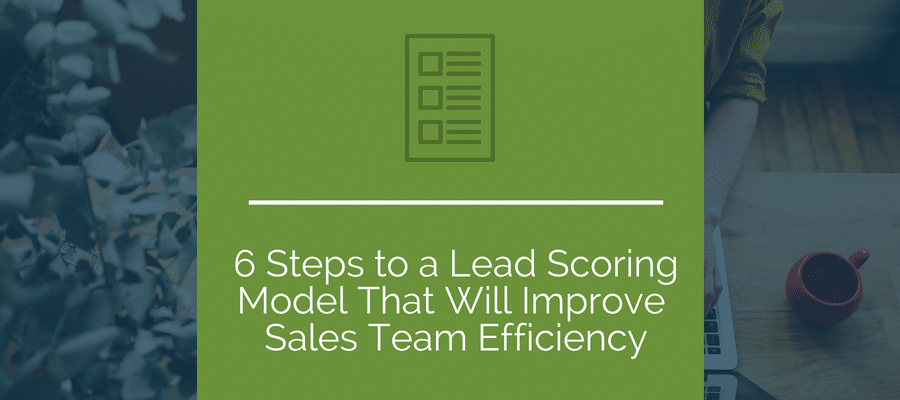
Using a lead scoring model to organize your leads is one of the best ways to keep your sales pipeline healthy and prosperous. It keeps marketing and sales teams on the same page, and improves sales team efficiency by spending time with the right leads.
Here are 6 Steps to an Effective Lead Scoring Model
Step #1: Create and Educate Your Team on Targeted Buyer Personas
In order for your sales and marketing teams to work together, everyone needs to be on the same page. The first step that should be taken prior to setting up your lead scoring model is to outline your key buyer personas. By creating detailed buyer personas that outline the demographics, identifiers and challenges of your target audiences you can ensure that everyone on your team has a clear and consistent picture of your ideal leads.
Step #2: Analyze Positive and Negative Lead Behaviors on Your Website
When analyzing leads, you’ll need to have the same set of rules that everyone on the team can follow as well. The next step to creating a lead scoring model that improves your sales team efficiency is to analyze both positive and negative behaviors that website visitors will have on your website or during communication with your team. For example, for positive lead behaviors, you may list out a hierarchy of web pages that a lead might visit and identify high value pages that often lead to a next step taken, including visiting information pages. You may also track marketing content downloads. For negative lead behavior you’ll track visits to web pages that may indicate they’re not a good lead like a visit to the careers page for example. You may also watch your email list closely to identify email unsubscribes.
Once you’ve laid out positive and negative behaviors your website visitors may have, you’ll next move on to analyzing the demographics of those that you’ve deemed a lead based on their positive behaviors.
Step #3: Analyze Lead Demographics
Once a website visitor has been deemed a lead, you’ll want to ensure that they fit with the buyer personas you and your team have agreed upon. To do so, you’ll take the data you’ve collected about them through forms on your website and dig deeper to match key demographic indicators with your buyer personas. You’ll analyze information like their title and role, the company they work for or own, their company size and the industry their company is in. This additional data will allow you to either rule them out as a sales qualified lead (SQL) or push them along the lead scoring cycle to be analyzed further.
Step #4: Map Our Your Lead Scoring Model
Once leads are identified as SQLs, you’ll then work on creating a lead scoring model that you can use to continue to analyze each of your potential leads. This scoresheet will utilize the behavior and demographic data you’ve collected and give it a number, both positive and negative. This will then give you and your team the ability to analyze your potential leads on a number scale and create a hierarchy of warm leads to hot leads.
Here’s an example of a potential lead scoring model that your team may use:
| Marketing Channel | Behavior | Score |
|---|---|---|
| Opened Email | +1 | |
| Clicked Link Within Email | +5 | |
| Unsubscribed | -5 | |
| Website | Visited Key Information Page | +10 |
| Visited Multiple Pages | +10 | |
| Visited Pricing Page | +10 | |
| Content | Downloaded the Guide | +10 |
| Attended Webinar | +15 | |
| Requested a Demo | +20 | |
| Category | Demographic Attribute | Score |
| Job Title | Marketing Manager or Business Owner? | +50 |
| Company Size | Large (100+ Employees) | +50 |
| Small (10 or Under Employees) | -10 | |
| Industry | Manufacturing, Real Estate or eCommerce | +30 |
| TOTAL |
Step #5: Implement Your Lead Scoring Model Into Your CRM
Once you have a numerical system in place to rate your leads, you’ll want to put this information into your CRM system. Implement these key attributes and actions and the score associated with them into your CRM system so that leads can automatically be altered and ordered by hierarchy. This will give your sales team an idea of hot leads that should be followed up with immediately and warm leads that may need more nurturing before they receive a call or email from the sales team.
Step #6: Continuously Improve Your Lead Scoring Model
Once you’ve created your lead scoring model, it won’t remain the same forever. Use data and common sense to assess how your lead scoring model is working to make necessary changes based on conversion rates. For example, you may notice that leads with a certain attribute don’t seem to convert like you thought they would, so it may be a smart move to give this attribute a lower rating. You should also continuously add to your lead scoring model to make sure all positive and negative attributes are accounted for.
Using a lead scoring model can help bridge the gap between your sales and marketing teams and ultimately improve your sales team efficiency. Taking the time to set up a well thought out lead scoring model will ensure that the leads that are sent to your sales team are handled appropriately. This will also vastly improve your lead and customer quality over time letting your company do what it does best.
What would you include in your lead scoring model? Let us know in the comments!
